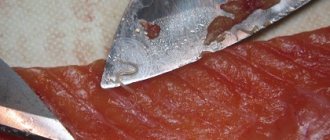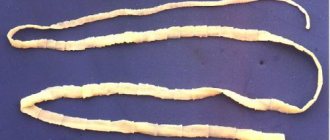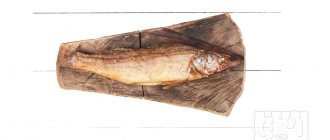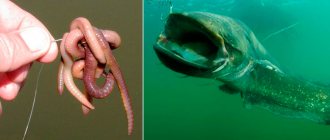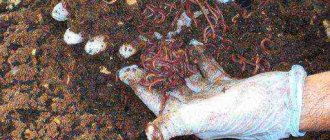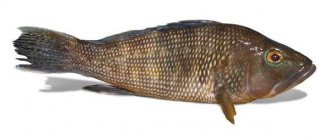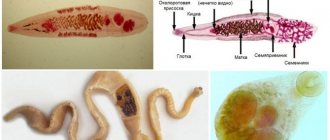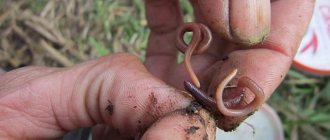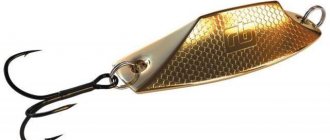What is an intestinal tapeworm?
The tapeworm, or Tenia solium in scientific language, is a parasite from the cystoid family of flatworms. These are tapeworms that can reach considerable lengths (several meters) and are equipped with a suction cup head and hooks that allow them to cling to intestinal drains in the host's body.
The body of the tapeworm consists of many segments (proglottids, segments) 1-1.5 cm long, which are connected together and form a kind of chain. Each additional proglottid increases the worm and its egg production. They can break off and be introduced along with the host's feces. This worm can survive even with only one head and a very small part of the neck.
Tapeworm can infect humans. In this case, they talk about taeniasis or cysticercosis.
Tapeworm infection can occur in two ways:
- When swallowing eggs. They enter the digestive tract and intestines of the host and here they can migrate to other organs and tissues. These eggs hatch into larvae. This is called an invasive infection. This form of infection can be very dangerous, as it causes the formation of cysts in the organs where the larvae develop. Cysts can compromise organ function. Particularly dangerous are infections that affect the brain, which can cause increased intracranial pressure, hydrocephalus, convulsions and seizures. The infection can also affect the eyes, in which case, if not treated quickly, vision loss may occur.
- When ingesting larvae. The larvae develop in the intestines and then grow into worms. In this case, you will have an intestinal infection. Intestinal infections, unlike invasive ones, usually cause many fewer problems.
Life cycle of tapeworm
We will begin the description of the cycle with an interesting fact: an adult worm can reach about 5 meters in length.
The tapeworm, having reached the intestines and not having its own digestive system, feeds on environmental products through osmosis (a physiological process that reduces the difference in the concentration of liquids and makes it possible for them to pass through the separating membrane).
Periodically, the tapeworm sheds proglottids (3 or 4), which are excreted in the feces through the intestines. Each proglottid can contain about 250,000 eggs, which, in conditions of poor hygiene, pollute the environment.
The life cycle of the worm requires the presence of an intermediate host, that is, pigs, which often consume food contaminated with Tenia Solium eggs. The eggs hatch into larvae that travel through the bloodstream into organs and muscle tissue.
The life cycle ends when a person, consuming raw meat or undercooked pork, ingests the larvae and becomes infected. A more complex and rare human infection occurs when eggs are ingested.
Tapeworm in fish: what does it look like and is it dangerous for humans?
Since meat is the main source of infection, you need to be careful. This also applies to fish, because they can harbor this parasite in their digestive tract and other organs. Entering the body along with fish meat, the tapeworm can become a parasite in the human digestive tract.
The most dangerous are the larvae, which are sometimes difficult to notice. Basically, since the parasite does not like salt water very much, it is found in freshwater fish. Although, it can also be found in some species of marine fish. When cleaning a fish, if there is already an adult parasite in its body, it is not difficult to notice when you see it. This is a white-cream colored tapeworm that is in no way similar to the intestines and other insides of the fish. But the larvae of the parasite cannot always be seen. In principle, fish with this parasite can be eaten, but only after careful heat treatment. Although, it is better, if you know for sure that it is infected, to throw it away.
Under no circumstances should you feed it to cats and dogs, even homeless ones, so as not to infect them with parasites. It is better to throw the fish in the trash.
The tapeworm can be found in a wide variety of fish. Most often, it is crucian carp and pike.
To protect yourself from dangerous meat infected with a parasite, you should buy it in trusted places: stores, large supermarkets, where there are documents for the goods, quality certificates and other relevant documents. You should not buy it at the market or along the road. When it comes to fishing, you should not fish in dangerous areas with a bad reputation. Dried, smoked fish pose the greatest risk, as they are almost raw. Sushi, which is now fashionable, can also pose a danger, because it also uses raw fish. Therefore, sushi should be eaten in proven, good restaurants with an impeccable reputation.
Kinds
Before starting effective treatment, it is necessary to determine the nature of the pathogen. The dangerous tapeworm worm occurs in several varieties in nature, has different specific life functions and methods of intensive therapy. The types of parasite are determined by the intermediate host, for example it can be a domestic animal, fish, cattle or pigs. To identify the disease and the characteristics of the pathogenic flora, it is necessary to take tests for tapeworm.
Bull tapeworm
This parasite is attached by suction cups to the intestinal walls and lives for a long time in the body of cattle, and you can become infected by eating contaminated beef. For example, larvae penetrate the gastrointestinal tract from a chop or other meat dish that is not properly fried. Bovine tapeworm in humans may not manifest itself in any way for many years, and the patient learns about the disease by chance during a routine test.
Pork tapeworm
The intermediate host in this clinical picture is a pig, and adult individuals are attached to the intestinal walls not with suction cups, but with special hooks. The larvae can spread throughout the body of an infected animal, so it is prohibited for humans to consume not only pork meat and lard, but also all offal. Pork tapeworm is difficult to remove from a pig’s body, and it is even more difficult to defeat the disease in the human body.
Tapeworms
Such parasites enter the human body along with infected fish and can be successfully treated effectively. Such a tapeworm causes a minimal number of complications, however, in any case, it requires immediate medical attention. If tapeworms continue to parasitize humans, diseases of the gastrointestinal tract become chronic, and the tapeworm progresses.
Dwarf tapeworm
The habitat of such a tapeworm is the body of domestic animals. These are cats, dogs and rodents that arbitrarily become carriers of a dangerous infection. The dwarf tapeworm is transmitted to humans, while in the digestive organs it behaves unpredictably. To avoid serious health consequences, people should worm their pets regularly.
Dog worm
Continuing the classification of tapeworms, it is recommended to focus on dog worms, which enter the human body from infected street animals. Even feces, in which a high concentration of viable eggs and larvae predominate, can become infected. Like the bovine tapeworm, the dog saltpeter worm is difficult to remove from the body; doctors do not even rule out surgical intervention.
Other types of tapeworms
- Tenia saginata. Parasitic human worms belonging to the family of flat cystoids and has, as an intermediate host, livestock.
- Tenia crassiceps. The worm is a parasite of wild dogs (coyotes), belonging to the cystoids, and has mice as an intermediate host. Humans can become infected by eating raw food contaminated with eggs released from coyote feces.
Varieties
So what is a tapeworm? In appearance, it is a long tape, reaching 12 meters in some cases. The scolex head, located at one end of the body, has special suction cups with which the worm extracts the substances necessary for its life. Depending on who was the intermediate host of worms, they are divided into several types.
These are:
- Bull tapeworm . This is a type of worm that begins to develop in cattle. It comes to people when they consume poorly cooked or fried beef meat. The worm multiplies rapidly and can live in the human body for several years without any symptoms.
One of the most dangerous parasites for humans: structure
- Pork tapeworm . The intermediate host is the pig. What is the tapeworm called pork tapeworm? This is a special parasite that differs from the bovine tapeworm in many ways. When it gets into contact with a person, it multiplies quickly. The eggs migrate throughout the body, affecting various organs. It is very difficult to remove from the body, and therefore it requires complex therapy.
In addition to suckers, the body of some helminths is equipped with hooks for attachment to the intestines.
Important! Pork tapeworm, despite its fairly simple structure, can be deadly.
- The broad tapeworm is a parasite that is found in the body of fish and in the human body. It brings comparatively less trouble to a person.
The wide tapeworm begins its development in the organs of the fish.
What does a tapeworm look like in a person?
Having studied the structure and size of an adult, it is important to understand that the worm can live in the small intestine for a long time (up to 20 years), causing acute digestive upset. The tapeworm in humans is a hermaphrodite and can self-fertilize. It can lay up to a million eggs per day, so getting rid of such a parasite will not be easy. When removing it, the main thing is not to break it, otherwise the remaining segments in the intestines are capable of growth and the formation of an adult individual. To exterminate pathogenic flora, it is important to remove the tapeworm along with the head and all segments.
What does an adult tapeworm look like in humans?
The tapeworm is a white or slightly pinkish color, the length of which varies from 1.5 to 17 meters. The parasite consists of the head part of the scolex, a neck and a chain of rectangular segments (segments) that form the body (strobila) of the adult worm. Tapeworms are hermaphrodites. Each segment has its own reproductive system and about 40,000 eggs. In an adult worm there can be from 300 to 10,000 such segments.
On the scolex of the tapeworm there are bothrial clefts, with which the worm pinches the lining of the small intestine of the victim and is fixed in a comfortable position.
These worms are long-lived. An adult can parasitize for 25 years, multiplying and poisoning the host’s body until the very end.
Interesting fact. In the 19th and first half of the 20th centuries, tapeworm segments were used as a means of losing weight. Noble ladies bought parts of parasites from pharmacists for a lot of money, swallowed them and, after some time, enjoyed an elegant figure and aristocratic pallor. Not everyone was able to breed a pet, so rarely did any of the voluntary owners of the worm live to a ripe old age. Due to a chronic lack of nutrients, the immune function of the body was suppressed; women easily fell ill with tuberculosis, pneumonia, various forms of anemia and other serious illnesses.
You can suspect the appearance of a tapeworm in a person based on symptoms characteristic of a specific type of invasion.
Symptoms of tapeworm infection
The symptoms that accompany a human tapeworm infection vary depending on the type of infection.
Possible symptoms of infection...
Invasive infection when eggs penetrate organs
In this case, eggs from the gastrointestinal tract migrate throughout the body and invade various organs, followed by the development of larvae. The latter, in turn, cause the formation of a cyst.
The clinical picture given by an invasive infection:
- Diffuse cysts. They form in organs or tissues into which eggs have migrated and larvae have hatched. A cyst can obviously jeopardize the functioning of the entire organ. So, for example, if the brain is affected (neurocysticercosis), it is possible that hydrocephalus will develop, that is, the accumulation of cerebrospinal fluid in the intracranial cavity, which leads to increased pressure, convulsions, and epileptic seizures.
- Allergic reactions of the larvae are possible. These reactions can have varying degrees of severity, up to anaphylactic shock.
- Bacterial infections. Organs or tissues infected by tapeworm larvae can become easy prey for bacteria, which can further aggravate symptoms.
- Fever. Caused by an inflammatory reaction that comes from the development of a cyst.
Intestinal infections worm attacks the intestinal wall
The clinical picture associated with intestinal tapeworm infection results from disturbances caused by the worm disrupting the mechanism of absorption of nutrients by the intestinal wall and minor inflammation caused by the hooks of the tapeworm head; in more serious cases, the symptoms are associated with the formation of an obstruction by the body of the worm.
In summary, symptoms and signs of intestinal Tenia Solium infection include:
- Nausea and indigestion.
- Pain in the lower abdomen.
- Diarrhea.
- Weakness due to poor absorption of nutrients.
- Weight loss as a direct consequence of decreased nutrient absorption.
- Anorexia induced bowel weakness.
- Eosinophilia, i.e. an increase in the concentration of eosinophils in the blood of more than 500 per microliter of blood. Eosinophils are cells of the immune system that are produced in response to the penetration of a parasite, in our case against Tenia Solium
Preventing tapeworm infection
Prevention, of course, is based on avoiding the above risk factors, that is:
- Thorough hand washing before every meal.
- Thoroughly wash fruits and vegetables that will be consumed raw with water.
- Drinking bottled water in regions where Tenia solium is endemic.
- Avoiding consumption of unprocessed fruits and vegetables in areas where tapeworm is endemic.
- Prevention of infection of pigs and removal of infected animals.
- Prolonged heat treatment of pork before consumption.
Symptoms of human tapeworm infection
It is rarely possible to easily determine the presence of this pest in the body. Over many years, they have already managed to adapt to the internal environment of a person, and may not manifest themselves at all. But a certain number of symptoms still exist:
- vomit,
- severe pain in the stomach and intestines,
- nausea,
- increased salivation,
- bad breath,
- bruises under the eyes,
- weakness and general malaise.
Tapeworm larvae often end up in feces and can easily be seen there. Mature worms can also be seen.
Advice: there is one method that has been proven over the years, thanks to which you can accurately determine the presence or absence of a tapeworm; after eating highly salted or spicy food, the infected person will feel unpleasant movements in the lower abdomen. And after drinking one glass of milk, all such sensations disappear. If these signs coincide, it means that the pest lives in the body.
Features of the course of diphyllobothriasis
Diphyllobothriasis is a disease caused by infestation of the broad tapeworm species helminth. This is the largest of all tapeworms (up to 17 m), which can parasitize the human small intestine for decades. Infection with diphyllobothriasis occurs through consumption of infected fish that has not undergone sufficient heat treatment, as well as lightly salted caviar. This disease most often affects people whose profession involves cutting fish carcasses.
Why is diphyllobothriasis dangerous?
Once in the small intestine of a person, the helminth tries to attach itself to its walls with the help of bothria. This injures the mucous membrane, and inflammatory processes and necrosis develop in the pinched areas. The wide tapeworm sucks nutrients from the food a person eats and provokes the development of hypovitaminosis B9, B12, and anemia. The toxin secreted by the parasite has a detrimental effect on the smooth muscles of the intestines and also disrupts the functions of the nervous system. Metabolites cause general intoxication of the body and provoke allergic reactions.
Main signs of infection:
The patient may complain of noticeable movement in the small intestine. This symptom is associated with a disruption of the mechanism of muscle contraction and the reactions of nerve endings under the influence of parasite toxins.
Definition of tapeworm in the human body
To make a diagnosis of taeniasis or teniarinhinosis, it is necessary to undergo a full examination prescribed by a parasitologist. First of all, the specialist must study the patient’s complaints; already at this stage one can suspect that the patient has a tapeworm in his body. The worm can come in different sizes, so symptoms may vary. After collecting complaints, it is necessary to carefully question the patient: what does he associate the disease with (after staying in contaminated places, eating meat products). The next step is to identify the pathogen in feces. To make an accurate diagnosis, it is necessary to do an ultrasound of the abdominal cavity, which will detect a large tapeworm.
Mechanisms that can lead to tapeworm infection
As already mentioned, human infection with tapeworm can develop through ingestion of eggs or larvae of the worm. Let's try to figure out how this can happen.
The intermediate host of the tapeworm is pigs, which spread the worm eggs along with their feces. In conditions of poor hygiene, feces of infected animals can contaminate the soil and, consequently, water and food. This occurs, in particular, when manure is used as fertilizer for agriculture.
Consuming foods contaminated with eggs can cause the development of an invasive infection. In addition, because the muscles of infected pigs contain tenia solium larvae, consumption of raw pork or poorly processed meat can lead to their passage into the intestines and intestinal infection.
| 676 | |
| [H3] – Life cycle of a tapeworm We will begin the description of the cycle with an interesting fact: an adult tapeworm can reach about 5 meters in length. The tapeworm, having reached the intestines and not having its own digestive system, feeds on environmental products through osmosis (a physiological process that reduces the difference in the concentration of liquids and makes it possible for them to pass through the separating membrane). Periodically, the tapeworm sheds proglottids (3 or 4), which are excreted in the feces through the intestines. Each proglottid can contain about 250,000 eggs, which, in conditions of poor hygiene, pollute the environment. The life cycle of the worm requires the presence of an intermediate host, that is, pigs, which often consume food contaminated with Tenia Solium eggs. The eggs hatch into larvae that travel through the bloodstream into organs and muscle tissue. The life cycle ends when a person, consuming raw meat or undercooked pork, ingests the larvae and becomes infected. A more complex and rare human infection occurs when eggs are ingested. |
Risk factors for tapeworm infection
There are some situations that can significantly increase the risk of tapeworm infection.
The most common are:
- Eating without previous thorough hand hygiene. By putting food into your mouth with dirty hands, you increase the likelihood of ingesting tapeworm eggs.
- Consuming dirty fruits and vegetables. These products may be contaminated with worm eggs; if they are consumed without first thoroughly washing with plenty of water, the risk of ingesting worm larvae increases significantly.
- Consumption of raw or undercooked pork meat. Pigs are the intermediate host of tapeworm and their muscles may contain worm larvae. If you eat raw or undercooked meat (all parts of the meat should be exposed to a temperature of about 60C for a sufficiently long time), you can introduce a tapeworm larva into the intestines. The worm will also die if the meat is frozen at -10C for at least ten days.
- Living in a rural area where there is no proper disposal of livestock waste. Failure to properly dispose of animal feces leads to contamination of the surrounding soil and water with tapeworm eggs and larvae.
- Living in or visiting endemic regions. Of course, if the worm is widespread in the area where you are staying, then the likelihood of infection increases significantly. Southeast Asia, China and Latin America should be considered.
- Using pig manure as fertilizer for agriculture. If some pigs are infected with tapeworm, tapeworm eggs will be present throughout the manure.
| 1417 |
[H3] – Prevention of tapeworm infection Prevention, of course, is based on avoiding the above risk factors, that is:
|
How does infection occur?
To become a sexually mature individual, this helminth must go through several stages of development. At these stages, the worm needs to enter the body of two intermediate living objects and one main one.
These stages of development include:
- Infected mammals release millions of immature eggs into the environment through their feces. Once in the natural environment, the eggs remain viable for a month. If they fail to get into a comfortable environment (water), then during this time they will simply die.
- If the eggs fall into the water (into a body of water), free-swimming larvae (procercoids) are released. At this stage, they enter the body of copepods, which are the first hosts of worms.
- As a rule, fish eat such copepods as food and, as a result, parasites enter the body of fish, which are another intermediate link in the development of this worm.
- At the last stage, the worms enter the body of humans or animals that eat fish infected with tapeworm.
Attaching to the intestinal walls, the larvae grow into adults in a short period of time.
It is important to know! If you eat infected fish without heat treatment, you can easily become a carrier of this worm.
Once in the human intestine, this parasite is able to multiply for 20 years, inhibiting it and taking away nutritional components.
Important to remember! Tapeworm larvae floating in water bodies do not pose any danger to humans, since they have not had time to go through the preliminary stages of their development.
Diagnostics: how to detect intestinal tapeworm
If you suspect that you have an intestinal tapeworm, you should contact a gastroenterologist. For an accurate diagnosis, you will be given a series of tests, since analysis of the clinical picture does not provide confidence in the presence of the parasite.
The following tests are widely used:
- Stool analysis. The stool is analyzed under a microscope to look for tapeworm eggs or proglottids. But since they are only released periodically, the test may have to be repeated several times before anything can be found. The presence of these elements in the stool makes it possible to accurately diagnose the presence of intestinal tapeworm.
- Blood analysis. Used to detect invasive tapeworm infection and looks for antibodies produced by the immune system to fight tapeworm larvae. Obviously, the presence of these antibodies indicates infection.
If a diagnosis of invasive tapeworm infection is made, then additional clinical studies are often required to search for affected organs and tissues.
Tapeworm in children
Young children are most susceptible to infection by parasitic worms. They are primarily at risk.
Their unconscious habit of putting toys and other objects into their mouths is the main cause of infection by various parasites and pathogenic microorganisms.
It is impossible to keep track of this, just as it is impossible to keep the objects around them completely sterile. Playing in the sandbox is one of the causative factors of tapeworm infection. After all, such objects are often visited by animals that are carriers of these parasites.
And children suffer to a greater extent from the effects on their body of toxins produced by parasites and from their functional activity.
The tapeworm parasite that enters a child’s body primarily slows down their development, both physical and emotional. Almost immediately, intestinal obstruction may develop, blocking the production of enzymes necessary for the body.
Blueness under the eyes and simultaneous puffiness, weight loss, deficiency of essential minerals and vitamins - all this is the effect of tapeworm on the child’s body.
Symptoms of the disease in children are more pronounced than in adults. Babies are characterized by seizures and fainting, bloating and enlarged tongue. They become whiny, lethargic, irritable and indifferent. Activity and passion for games disappear, memory is impaired.
If such symptoms are noticed, you should definitely contact your treating pediatrician for advice for a possible examination and subsequent treatment.
Treatment of tapeworm in humans
Only after determining the nature of the pathogenic pathogen and the general condition of the body, the doctor prescribes a course of treatment, often based on the implementation of conservative methods. The main goal of tapeworm treatment is to destroy pathogenic flora, prevent its reproduction and spread in the digestive tract. This applies equally to adult patients and victims of helminths in childhood.
If the tapeworm has reached a considerable size, it is difficult for it to emerge naturally, and it is very problematic to exterminate such a pest from the inside. Based on the results of an ultrasound scan at the last stage of development of the microbe, the doctor recommends surgical intervention followed by a rehabilitation period. Be sure to follow good personal hygiene to minimize the risk of re-infection.
Tapeworm Treatment and Natural Remedies
An intestinal tapeworm infestation does not always require treatment, as in many cases the worm will be removed by the body. In other cases, the infection can last for years without the patient even noticing symptoms.
Pharmacological treatment is based on the administration of active substances that are not absorbed by the intestine and which are fatal to the worm.
The drug most commonly used worldwide to combat intestinal tapeworm is Praziquantel. To facilitate complete removal of the parasite, it is recommended to use a laxative several hours after taking the antiparasitic drug.
Monitoring in the following months is important, as a piece of the worm may remain in the intestines or re-infection through the hands may occur. In the period immediately after therapy, it is important to maintain maximum hygiene to avoid possible re-infection.
Invasive infections are treated differently, depending largely on the location of the tapeworm cyst. However, as a rule, treatment includes:
- Taking drugs to remove the worm (anthelmintic).
- Anti-inflammatory corticosteroids. Serve to reduce inflammation and swelling that appear from cysts in the affected organs.
- Surgical intervention. In some cases, surgery may be required to remove the cyst to avoid serious symptoms and organ dysfunction.
Drug therapy
The best option for getting rid of tapeworm is to take medications prescribed individually by your doctor. The intensive therapy regimen is based on the use of anthelmintic drugs in a course. It is important to understand that one dose of the selected medication does not result in effective treatment of tapeworm in humans with tablets. Therefore, at first it is necessary to take the prescribed medication three times, and after a few days another one-time use. In general, the duration of therapy reaches 10 days. These may be the following medications:
- Gelmodol-VM. Paralyzes the tapeworm, after which it hatches adults, larvae and eggs with feces;
- Vermox. Affects small parasites, including helminths and pinworms;
- Sanoxal. Destroys the walls of helminths, is an auxiliary treatment if tapeworm progresses in humans;
- Mebendazole. It provokes impaired glucose production, and the tapeworm dies;
- Albendazole. It has pronounced anthelmintic properties and violates the integrity of tapeworm membranes;
- Vormin. A synthetic drug against parasitic microorganisms in the intestines;
- Medamin. Blocks the nervous system of parasites, paralyzes them, promotes rapid elimination from the body.
Additionally, it is necessary to take immunostimulating drugs to increase the immune response of a weakened body. These may be medications with the active ingredient echinacea. Probiotics are also included in the complex treatment regimen, and their main goal is the productive restoration of the intestinal microflora and the colonization of its environment with beneficial bacteria. Medicines such as Linex, Hilak Forte, Bifidumbacterin and others have proven themselves well.
Natural Remedies for Tapeworm
Natural remedies are quite popular for treating intestinal tapeworm infestations. The most common are garlic, pumpkin seeds, and chamomile. But it should be noted that all these remedies have only a mild therapeutic effect; however, they are not able to eradicate the infection.
Surgical intervention
The operation is performed in those clinical situations where tablets do not help get rid of the worm. This happens due to its large size. Surgical removal of tapeworm requires preliminary diagnosis, and is appropriate in the following clinical situations:
- exacerbation of appendicitis, provoked by increased tapeworm activity;
- blockage of the bile ducts by segments;
- penetration of the tapeworm into the eyes, its location near the brain;
- location of segments in the pancreas;
- low effectiveness of drug therapy in humans.
Folk remedies
This is an auxiliary therapy, no less effective in practice, which accelerates the overall therapeutic effect. Approved by infectious disease doctors. Additionally, it is required to observe the rules of personal hygiene, control the daily diet, and take medications. Effective treatment of tapeworm with folk remedies involves the use of the following alternative medicine recipes:
- In the morning, eat a glass of peeled pumpkin seeds, and half an hour later, wash down this folk medicine with warm milk, in which you have first boiled a few cloves of garlic.
- 100 g of pumpkin seeds are first peeled and crushed into puree. After this, dilute the gruel with lingonberry juice and take it between adjacent meals, washing it down with a tablespoon of pharmaceutical castor oil.
- Grind 10 heads of garlic into a pulp, then dilute with water and eat, washing down the concentrate with warm milk. After a couple of hours, take a laxative. The product is suitable in the absence of chronic diseases of the gastrointestinal tract.
To finally remove tapeworm, a person needs to further review their daily diet. The emphasis should be on salty and peppery dishes, since these contribute to the rapid removal of joints along with feces. The menu should be selected individually, taking into account the state of the digestive organs and the degree of the pathological process.
Prevention of infection
To prevent tapeworm from appearing in the body, it is necessary to observe the rules of personal hygiene, and all food products must be subject to mandatory heat treatment. This way you can avoid treatment and serious complications in the body. The tapeworm starts in places where there are no sanitary standards, so a person must live in cleanliness and be clean. Other preventive measures are detailed below:
- Cooking food, especially meat and fish products, must be carried out at a temperature of at least 100 degrees.
- If the family has pets, they must be systematically wormed for prevention purposes.
- It is important to eliminate human interaction with rodents and harmful insects, which are potential carriers of pathogenic infection.
- It is important to teach children to wash their hands every time they come in from outside, before eating, and after visiting the toilet.
- Treatment of tapeworm in the body should begin in a timely manner, remembering its rapid reproduction in the walls of the small intestine.
